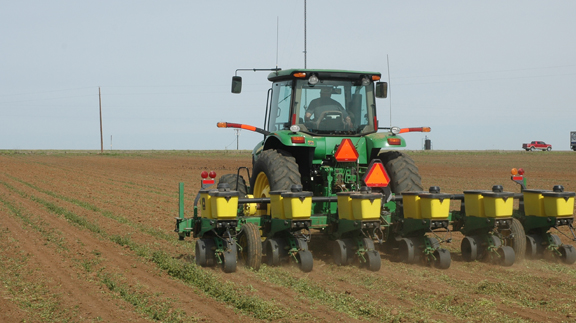Farm & Ranch
[AgriLife Today] Texas to see 300,000-acre increase in planted corn acres for 2016

By: Blair Fannin
Writer: Blair Fannin, 979-845-2259, [email protected]
Contact: Dr. Mark Welch, 979-845-8011, [email protected]
COLLEGE STATION – Texas is projected to see an increase of 300,000 acres of corn planted for 2016 following a recent U.S. Department of Agriculture expected plantings report, which confirmed a broad-scale increase in corn acreage across the nation.
Significant shifts have been seen on the western edge of the Corn Belt from North Dakota to Texas as corn acres are projected to be up 2.25 million acres, said Dr. Mark Welch, Texas A&M AgriLife Extension Service grain marketing economist, College Station.
Texas is projected to plant 2.6 million acres of corn in 2016 compared to 2.3 million acres in 2015. The 300,000-acre increase is attributed to wet conditions during the fall, which prohibited farmers in the Central Texas Blacklands region and along the Interstate 35 corridor from planting wheat, Welch said.
“That left many farmers leaning towards corn since the moisture was favorable and corn budgets looked better versus other commodities,” Welch said.
The threat of the sugarcane aphid has left some Texas farmers to opt for corn with already record-high sorghum yields booked in 2015.
In his recent Feed Grain Outlook report, Welch said the USDA’s expected plantings report, “if realized and yields are at or near trend line, corn supplies could reach 16 billion bushels and carry over 2.3 billion bushels.”
Other grains will see fewer planted acres, Welch noted. U.S. wheat acres are projected to be down 5 million acres compared to 2015 and sorghum down 1.2 million acres.
“We were already expecting more corn acres to be planted this year and the USDA report confirmed it,” he said.
Though corn prices have fallen due to U.S. farmers’ intentions to plant more corn, farmers can offset that revenue loss with more volume, Welch said.
“If a farmer feels that they’ve got the moisture and there’s favorable chances for moisture to continue through the growing season, they can make more bushels to make up for the lower price.”
Another factor is the financial capacity of some farming operations. Welch said for producers carrying over large debt from the previous year, a big question is will they have enough capital needed to plant a new crop?
“If not, will there be someone else to come in and pick up the land (in time before the planting window closes)?” Welch said.
Low commodity prices and increased loan demand are concerns for ag lenders across the country, Welch said. Several farm income safety net programs, such as crop insurance and the Agriculture Risk Coverage, or ARC, program in the farm bill, offer lower levels of security in times of low commodity prices.
“But that all depends on how each farmer is structured and their cost of production,” Welch said.
Some farmers in Texas have been diversifying by planting oilseed crops to offset depressed prices in corn, cotton and other commodities, Welch said.
“Overall, the USDA report was a wake-up call in that we are capable of planting considerably more corn compared to recent years,” Welch said.
Welch distributes a Feed Grain Outlook, which can be subscribed to via email at [email protected] or by calling 979-845-8011.
-30-
LikeTweet
Find more stories, photos, videos and audio at http://today.agrilife.org
Farm & Ranch
Ag Elsewhere: Wyoming

By Tressa Lawrence
Babies are tucked away in every nook and cranny. Many ranchers across Wyoming have baby animals popping up all over this time of year.
Farm & Ranch
Ag Elsewhere: Montana

By Lindsey Monk
Another load of grain in to keep feeding the calves until the green grass can really start popping.
Farm & Ranch
Meanwhile, Back at the Ranch….

By Rayford Pullen | [email protected]
Spring has sprung and hopefully the rains will continue where our country will heal from the previous droughts and our grasses will thrive. We are especially hopeful for the Panhandle of Texas where our neighbors and friends have been dealt a deadly blow to homes, ranges, livestock, and people. Keep them in your prayers as they will not be able to return to normal for many years if at all. Having lost their ability to benefit from this great cattle market is a double whammy for all of them.
Now is the time of year when we need to take care of business as it relates to our new calves that have been hitting the ground this spring. First and foremost is vaccinating for Blackleg followed by deworming with a white wormer and the IBR complex. Blackleg is a soil-born disease and with pastures extremely short this spring our calves have been grazing the green grass as soon as it shows itself, making them even more vulnerable to picking contaminates from the soil.
To read more, pick up a copy of the April issue of NTFR magazine. To subscribe by mail, call 940-872-5922.
-

 Country Lifestyles1 year ago
Country Lifestyles1 year agoScott & Stacey Schumacher: A Growth Mindset
-

 Equine7 months ago
Equine7 months agoThe Will to Win
-

 Country Lifestyles7 years ago
Country Lifestyles7 years agoStyle Your Profile – What your style cowboy hat says about you and new trends in 2017
-

 Country Lifestyles4 years ago
Country Lifestyles4 years agoAmber Crawford, Breakaway Roper
-

 HOME7 years ago
HOME7 years agoGrazing North Texas – Wilman Lovegrass
-

 Country Lifestyles7 years ago
Country Lifestyles7 years agoDecember 2016 Profile, Rusty Riddle – The Riddle Way
-

 Country Lifestyles8 years ago
Country Lifestyles8 years agoJune 2016 Profile – The man behind the mic: Bob Tallman
-

 Country Lifestyles8 years ago
Country Lifestyles8 years agoCowboy Culture with Clay Reid – Being a Man






